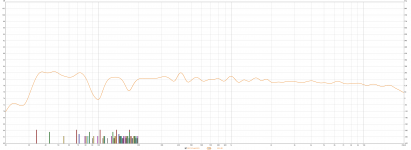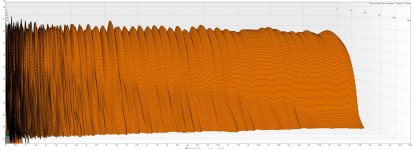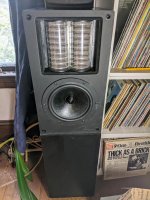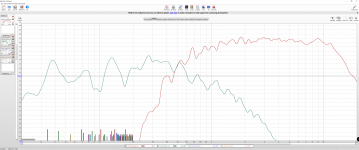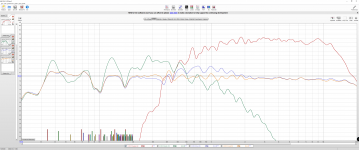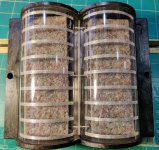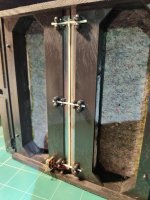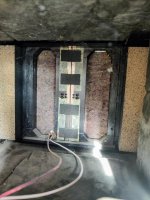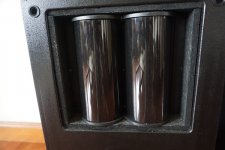[ Thread split from here - Introduction to designing crossovers without measurement]
Thread split from here - Introduction to designing crossovers without measurement]
Folks, this is an amazing thread, and there is literally too much information - making it difficult to comb through.
My question is this:
I have been using a miniDSP 2x4 HD active crossover, and biamping my 2-way transmission line Linaeum LT1000 speakers. I have settled the crossover design using REW with a miniDSP UMIK-1, and listening, and making custom driver EQ filters. These are loaded into the 2x4 HD and I have been listening to it for many months.
The crossover frequency is 440Hz (yes, really) and I am using 4th order Linkwitz Riley slopes. To be precise, the woofer is a 24dB/octave in the 2x4 HD - and the TLS tweeter is an 18dB/octave - and there is a 22uF capacitor in series with the tweeter. I am assuming this is effectively a 24dB/octave slope, as well.
The reason I did this was for our friend Justin Case. I didn't want to risk these tweeters, which are the definition of extremely rare.
*Is there a guide for how I would go about picking the values of parts to build an analog 4th order LR crossover, at 440Hz?
I am then going to need to add a resistor(s) to the tweeter, given it is 1-2dB louder than the woofer, and I am aiming at a so-called "room curve". In REW, I am using the default one they suggested: flat between 200Hz and 1kHz, with +1dB per octave below 200Hz (so a total of +3dB at 20Hz) - and a -0.5dB/octave above 1kHz (so a total of -3dB at 20kHz).
I am intending to build a MLTL cabinet for the Dayton Audio RS225P-4A woofer. I have all the data on these woofers. The challenge is for the needed data on the Linaeum TLS tweeter. I can obviously measure the DC resistance (I *think* it was around 6 ohms?) Do I need additional data to build the crossover?
Any and all advice and information you can tell me, would be greatly appreciated. I have only done the crossover in the 2x4 HD - which I highly recommend, by the way, for this purpose at least. I was highly skeptical of it - but it sounds really good! I think that the upside is that the amps power the drivers directly - the woofer in particular benefits from this, I think. Having the ADC / DSP / DAC stages may seem problematic (I had serious doubts!) but listening has proved to me, that I was wrong.
This is the in-room frequency response and waterfall measured with REW. The dips I think are the 32 year old TL design. I *think* I have got a new cabinet that will eliminate these, and extend the bass quite a bit lower. Which is going to be amazing, if it works as I hope. The Linaeum TLS tweeter is a Paul Paddock masterpiece.
 Thread split from here - Introduction to designing crossovers without measurement]
Thread split from here - Introduction to designing crossovers without measurement]Folks, this is an amazing thread, and there is literally too much information - making it difficult to comb through.
My question is this:
I have been using a miniDSP 2x4 HD active crossover, and biamping my 2-way transmission line Linaeum LT1000 speakers. I have settled the crossover design using REW with a miniDSP UMIK-1, and listening, and making custom driver EQ filters. These are loaded into the 2x4 HD and I have been listening to it for many months.
The crossover frequency is 440Hz (yes, really) and I am using 4th order Linkwitz Riley slopes. To be precise, the woofer is a 24dB/octave in the 2x4 HD - and the TLS tweeter is an 18dB/octave - and there is a 22uF capacitor in series with the tweeter. I am assuming this is effectively a 24dB/octave slope, as well.
The reason I did this was for our friend Justin Case. I didn't want to risk these tweeters, which are the definition of extremely rare.
*Is there a guide for how I would go about picking the values of parts to build an analog 4th order LR crossover, at 440Hz?
I am then going to need to add a resistor(s) to the tweeter, given it is 1-2dB louder than the woofer, and I am aiming at a so-called "room curve". In REW, I am using the default one they suggested: flat between 200Hz and 1kHz, with +1dB per octave below 200Hz (so a total of +3dB at 20Hz) - and a -0.5dB/octave above 1kHz (so a total of -3dB at 20kHz).
I am intending to build a MLTL cabinet for the Dayton Audio RS225P-4A woofer. I have all the data on these woofers. The challenge is for the needed data on the Linaeum TLS tweeter. I can obviously measure the DC resistance (I *think* it was around 6 ohms?) Do I need additional data to build the crossover?
Any and all advice and information you can tell me, would be greatly appreciated. I have only done the crossover in the 2x4 HD - which I highly recommend, by the way, for this purpose at least. I was highly skeptical of it - but it sounds really good! I think that the upside is that the amps power the drivers directly - the woofer in particular benefits from this, I think. Having the ADC / DSP / DAC stages may seem problematic (I had serious doubts!) but listening has proved to me, that I was wrong.
This is the in-room frequency response and waterfall measured with REW. The dips I think are the 32 year old TL design. I *think* I have got a new cabinet that will eliminate these, and extend the bass quite a bit lower. Which is going to be amazing, if it works as I hope. The Linaeum TLS tweeter is a Paul Paddock masterpiece.
Attachments
Last edited:
The way I'd go about this depends on whether you want to directly mimic the existing crossover. It appears from your measurement that you've used EQ to get there. It's less clear how much you've included the room in those measurements.
You could measure the signal at each amplifier, and use that as a target curve for each driver, putting it into a crossover simulator and using the measured impedance of each driver.
It may even be worth its own thread.
You could measure the signal at each amplifier, and use that as a target curve for each driver, putting it into a crossover simulator and using the measured impedance of each driver.
It may even be worth its own thread.
Hi Allen,
The process for using the miniDSP 2x4 HD *definitely* uses PEQ filters. I used REW (Room Equalization Wizard) to measure the drivers, with sweeps (so, yes this may need to move to a new thread?), and then I did a lot of listening tests with various crossover settings.
Once I settled on the 4th order Linkwitz Riley slopes at 440Hz - I used REW to measure each driver at the same position of the UMIK-1 (which is miniDSP's calibrated USB mic). It was about 1 meter on the listening axis, at the midpoint between the two drivers. I have uploaded a picture of my Linaeum LT1000, to make it easier to visualize.
There is a PEQ filter for each driver on its own. And then as a system, I measured the speaker with REW an made another PEQ filter, targeting the "room curve" I mentioned in my post. And that is what I measured for the response graphs that I posted.
These speakers sound incredible - BETTER than anything I have heard in my 45+ years off listening to music. The Linaeum TLS tweeter is a masterpiece.
The stock transmission line cabinets of the LT1000 are very good, but I think (most) of the dips in the response are because the transmission line was designed 32 years ago. I have been working on designing a model in Hornresp, and drawing the cabinet in DataCAD (which is how I earned a living). That thread is here: https://www.diyaudio.com/forums/ful...ansmission-line-alignment-31.html#post6477392
I am fine with continuing to use an active crossover, and biamping. But I am also hoping to see if I can make a conventional crossover, to be able to compare it to the 2x4 HD active crossover.
I also want to build a version of the Linaeum Model 10 - which is another speaker that used the 1.5" high Linaeum tweeter - like the ones made by Radio Shack. That would use the 8 ohm version of the Dayton Audio RS225P woofer, in the same MLTL cabinet I modeled. That will obviously use a crossover at about 2kHz (or possibly a bit lower) and it may only need a 1st or 2nd order slopes
I am VERY impressed with the miniDSP 2x4 HD unit. It may not be ideally built - it probably doesn't have great op amps, or ADC or DAC chips. But, it is an amazing tool AT LEAST for speaker designers - to quickly try virtually endless combination of crossover designs. If I can learn to do this - I'm sure that folks with knowledge and experience designing crossovers will appreciate it.
The process for using the miniDSP 2x4 HD *definitely* uses PEQ filters. I used REW (Room Equalization Wizard) to measure the drivers, with sweeps (so, yes this may need to move to a new thread?), and then I did a lot of listening tests with various crossover settings.
Once I settled on the 4th order Linkwitz Riley slopes at 440Hz - I used REW to measure each driver at the same position of the UMIK-1 (which is miniDSP's calibrated USB mic). It was about 1 meter on the listening axis, at the midpoint between the two drivers. I have uploaded a picture of my Linaeum LT1000, to make it easier to visualize.
There is a PEQ filter for each driver on its own. And then as a system, I measured the speaker with REW an made another PEQ filter, targeting the "room curve" I mentioned in my post. And that is what I measured for the response graphs that I posted.
These speakers sound incredible - BETTER than anything I have heard in my 45+ years off listening to music. The Linaeum TLS tweeter is a masterpiece.
The stock transmission line cabinets of the LT1000 are very good, but I think (most) of the dips in the response are because the transmission line was designed 32 years ago. I have been working on designing a model in Hornresp, and drawing the cabinet in DataCAD (which is how I earned a living). That thread is here: https://www.diyaudio.com/forums/ful...ansmission-line-alignment-31.html#post6477392
I am fine with continuing to use an active crossover, and biamping. But I am also hoping to see if I can make a conventional crossover, to be able to compare it to the 2x4 HD active crossover.
I also want to build a version of the Linaeum Model 10 - which is another speaker that used the 1.5" high Linaeum tweeter - like the ones made by Radio Shack. That would use the 8 ohm version of the Dayton Audio RS225P woofer, in the same MLTL cabinet I modeled. That will obviously use a crossover at about 2kHz (or possibly a bit lower) and it may only need a 1st or 2nd order slopes
I am VERY impressed with the miniDSP 2x4 HD unit. It may not be ideally built - it probably doesn't have great op amps, or ADC or DAC chips. But, it is an amazing tool AT LEAST for speaker designers - to quickly try virtually endless combination of crossover designs. If I can learn to do this - I'm sure that folks with knowledge and experience designing crossovers will appreciate it.
Attachments
Last edited:
It just goes to show how far you can go tweaking by ear. Only in-depth measurement and advanced crossover techniques can get you further, but they take time to learn. After which you tweak by ear again...
You ask about the woofer response. I'm guessing you are measuring in your room. That might explain it.
In my experience it isn't the kind of crossover you use, it's how you use it that counts.
You ask about the woofer response. I'm guessing you are measuring in your room. That might explain it.
If you can get the filters to do the same thing, then the result will be similar indeed.make a conventional crossover, to be able to compare it to the 2x4 HD active crossover.
In my experience it isn't the kind of crossover you use, it's how you use it that counts.
This thread may be useful:
Design using the Linaeum ribbon -
Techtalk Speaker Building, Audio, Video Discussion Forum
Design using the Linaeum ribbon -
Techtalk Speaker Building, Audio, Video Discussion Forum
Thanks for splitting this to its own thread.
The main thing I am hoping to learn from folks here, is how to select the values for crossover components - what data do I need to know about the drivers? After the filters are determined, I will need to learn how to balance the levels of the drivers - probably the tweeter needs to be brought down.
The first crossover is a 4th order (24dB/octave) at 440Hz, for the Dayton Audio RS225P-4A (4 ohm) woofer and the 6" high Linaeum TLS (true line source) tweeter. This one I have already tested and tweaked with the miniDSP 2x4 HD.
The second crossover is probably 2nd order (12dB/octave) at about 1.5-2kHzm for the RS225P-8A (8 ohm) woofer and the 1.5" high Radio Shack made Linaeum tweeter. This one will need to be designed with the miniDSP 2x4 HD in the future.
The main thing I am hoping to learn from folks here, is how to select the values for crossover components - what data do I need to know about the drivers? After the filters are determined, I will need to learn how to balance the levels of the drivers - probably the tweeter needs to be brought down.
The first crossover is a 4th order (24dB/octave) at 440Hz, for the Dayton Audio RS225P-4A (4 ohm) woofer and the 6" high Linaeum TLS (true line source) tweeter. This one I have already tested and tweaked with the miniDSP 2x4 HD.
The second crossover is probably 2nd order (12dB/octave) at about 1.5-2kHzm for the RS225P-8A (8 ohm) woofer and the 1.5" high Radio Shack made Linaeum tweeter. This one will need to be designed with the miniDSP 2x4 HD in the future.
I made these suggestions, tell us what you are comfortable with.
Take a measurement of the response at each amplifier with the current crossover. Keep the levels as they are. Use these as driver targets.
Measure the impedance of each driver to use in the sims.
Use a flat response to begin with for each driver because this method cancels that part out.
Then we can work on what the circuit looks like.
Take a measurement of the response at each amplifier with the current crossover. Keep the levels as they are. Use these as driver targets.
Measure the impedance of each driver to use in the sims.
Use a flat response to begin with for each driver because this method cancels that part out.
Then we can work on what the circuit looks like.
Hi Allen,
To measure the response at each amplifier - would this require an oscilloscope? Because I do not have one.
Do I need to measure the DC resistance of each driver? I can do that.
To measure the response at each amplifier - would this require an oscilloscope? Because I do not have one.
Do I need to measure the DC resistance of each driver? I can do that.
That's not going to do it. Would it be possible to measure the response versus frequency out of your amps, so it looks like your speaker measurements? You'd use REW for that as well, you just don't use the mic (we can help).
There are also other ways to do this, like trying to match the speaker response to the current microphone measurement. In that case the first thing is to ensure you can get consistency of that measurement.. can you approach the speaker on any given day and take a near identical measurement of it?
On top of that, if you are going to make use of a simulator to make this easier it is going to be important to take a measurement of the driver impedance versus frequency (you might be lucky enough to find one, maybe not as accurate but useable).
Otherwise you might begin throwing components at the crossover and measuring the result to see what they do.
There are also other ways to do this, like trying to match the speaker response to the current microphone measurement. In that case the first thing is to ensure you can get consistency of that measurement.. can you approach the speaker on any given day and take a near identical measurement of it?
On top of that, if you are going to make use of a simulator to make this easier it is going to be important to take a measurement of the driver impedance versus frequency (you might be lucky enough to find one, maybe not as accurate but useable).
Otherwise you might begin throwing components at the crossover and measuring the result to see what they do.
Okay, I am going to ask some beginner questions - I wonder if there is a way to use the PEQ files that I made for the 2x4 HD that we can get the information we need?
I am trying to understand how the amps enter into this? The crossover settings are implemented in the digital domain (I think?), and so are the PEQ filters.
I can measure the raw drivers without any crossover or EQ. What is the starting point for this? How would I use REW to get what we need?
And, I just realized that I want to do this for the NEW cabinets, that I have not built yet. So, if I have to wait to get data, then there will be a pause until I can find a source for Baltic birch. The one place that I have heard back from (out of three that I have contacted) doesn't seem to want to deal with me. They are a wholesale supplier, and typically sell to cabinet makers, etc.
I am trying to understand how the amps enter into this? The crossover settings are implemented in the digital domain (I think?), and so are the PEQ filters.
I can measure the raw drivers without any crossover or EQ. What is the starting point for this? How would I use REW to get what we need?
And, I just realized that I want to do this for the NEW cabinets, that I have not built yet. So, if I have to wait to get data, then there will be a pause until I can find a source for Baltic birch. The one place that I have heard back from (out of three that I have contacted) doesn't seem to want to deal with me. They are a wholesale supplier, and typically sell to cabinet makers, etc.
Using the EQ data doesn't take into account the gain of the amplifier chains. You can measure this manually and adjust the relative levels yourself if you want.
The thing about measuring the raw drivers is that it doesn't relate in any way to what you've currently done and decided you are happy with. On the other hand if you want to begin the crossover from scratch and achieve a new result, then you'd want that data.
The thing about measuring the raw drivers is that it doesn't relate in any way to what you've currently done and decided you are happy with. On the other hand if you want to begin the crossover from scratch and achieve a new result, then you'd want that data.
Well, if I know the crossover frequency and slopes, then that is a big first step, right? To measure the raw drivers, it would be the same amp, and the same volume. I can't expect to get as flat response.
On the new MLTL cabinet, I am planning on using the 4 ohm Dayton woofer, rather than the 8 ohm - this lifts the bass by almost 3dB, and this means the highest octave will possibly be rolled off relative to now, because I can't "shave" it off as much.
And that is part of the compromises with active vs passive crossovers. The amp sees more complex loading with passive, vs the ADC/DSP/DAC stages being in the signal path.
Here are two screen captures from REW - the first is the 8 ohm woofer and the Linaeum tweeter with 2nd order digital crossover slopes (the tweeter also has the 22uF cap, so it is about 3rd order). And the second is those same driver sweeps, and the sytem with driver EQ applied, and the system with overall EQ also applied.
You can see why I want another 3dB from the woofer (and why the new MLTL cabinet will be a good thing). But the tweeter is still significantly more efficient - though I will have to do new sweeps with the same amp.
On the new MLTL cabinet, I am planning on using the 4 ohm Dayton woofer, rather than the 8 ohm - this lifts the bass by almost 3dB, and this means the highest octave will possibly be rolled off relative to now, because I can't "shave" it off as much.
And that is part of the compromises with active vs passive crossovers. The amp sees more complex loading with passive, vs the ADC/DSP/DAC stages being in the signal path.
Here are two screen captures from REW - the first is the 8 ohm woofer and the Linaeum tweeter with 2nd order digital crossover slopes (the tweeter also has the 22uF cap, so it is about 3rd order). And the second is those same driver sweeps, and the sytem with driver EQ applied, and the system with overall EQ also applied.
You can see why I want another 3dB from the woofer (and why the new MLTL cabinet will be a good thing). But the tweeter is still significantly more efficient - though I will have to do new sweeps with the same amp.
Attachments
Sure.if I know the crossover frequency and slopes, then that is a big first step, right?
Originally you mentioned comparing passive to active. In order to do that you have to make an accurate copy, otherwise they will definitely sound different. It's your choice.
You can get that fiddly correction done passive. Many say you can't, or it's difficult.I can't expect to get as flat response.
OK, so you are going to make significant changes.I am planning on using the 4 ohm Dayton woofer, rather than the 8 ohm - this lifts the bass by almost 3dB, and this means the highest octave will possibly be rolled off relative to now, because I can't "shave" it off as much.
What does this matter?And that is part of the compromises with active vs passive crossovers. The amp sees more complex loading with passive, vs the ADC/DSP/DAC stages being in the signal path.
Hi Allen,
I am hoping to make the best possible speaker using the Linaeum TLS tweeter, as I can.
Also, I want to build the same MLTL cabinet for a speaker with the Radio Shack made Linaeum tweeter.
The stock LT1000 cabinet (as the stock Vifa woofer was for that matter) are the weak link in it now. I *think* I have solved the cabinet, with one that has much flatter response, and somewhat deeper bass, as well.
I am happy with the sound of the active crossover, but if I can get a passive crossover that is as good or better overall, then that simplifies the amp situation. And for the second goal of a speaker with the Radio Shack sourced tweeter (which are relatively common), I definitely don't want to have to biamp it.
How I *though* this might go is, after I build the new MLTL cabinets with the 4 ohm woofers (which I have in hand), then I would do sweeps with the raw drivers, and with the active crossover and the intended slopes - but with no EQ, all with one amp. I then would do new EQ (while using both amps) to set the "standard".
I will be aiming for the REW "house curve" at the best SPL level to get as close to the house curve as possible.
That would be the target for the passive crossover. I am a novice at building crossovers. So, I may not understand the way this should happen.
I had assumed that with the right driver data (which is difficult on the tweeter, since it was never published), that the basic 4th order filters could be figured, and then listen and measure, to see what was needed to approach the house curve response.
It may be that I would hit the limit of what I can manage as a novice - and I would see the promise of what a passive crossover has; and decide to see if it could be done by a professional? OR, it may not be worth even more effort, and/or some company comes out with a better quality active crossover - and I go back to that.
And the second speaker I am intending to build, with the Radio Shack made Linaeum tweeter, will be a much simpler crossover - 1st or 2nd order at a much more conventional frequency, and with (probably) much easier to match drivers. And I don't want to have to biamp this. A passive crossover is required for this one.
I am hoping to make the best possible speaker using the Linaeum TLS tweeter, as I can.
Also, I want to build the same MLTL cabinet for a speaker with the Radio Shack made Linaeum tweeter.
The stock LT1000 cabinet (as the stock Vifa woofer was for that matter) are the weak link in it now. I *think* I have solved the cabinet, with one that has much flatter response, and somewhat deeper bass, as well.
I am happy with the sound of the active crossover, but if I can get a passive crossover that is as good or better overall, then that simplifies the amp situation. And for the second goal of a speaker with the Radio Shack sourced tweeter (which are relatively common), I definitely don't want to have to biamp it.
How I *though* this might go is, after I build the new MLTL cabinets with the 4 ohm woofers (which I have in hand), then I would do sweeps with the raw drivers, and with the active crossover and the intended slopes - but with no EQ, all with one amp. I then would do new EQ (while using both amps) to set the "standard".
I will be aiming for the REW "house curve" at the best SPL level to get as close to the house curve as possible.
That would be the target for the passive crossover. I am a novice at building crossovers. So, I may not understand the way this should happen.
I had assumed that with the right driver data (which is difficult on the tweeter, since it was never published), that the basic 4th order filters could be figured, and then listen and measure, to see what was needed to approach the house curve response.
It may be that I would hit the limit of what I can manage as a novice - and I would see the promise of what a passive crossover has; and decide to see if it could be done by a professional? OR, it may not be worth even more effort, and/or some company comes out with a better quality active crossover - and I go back to that.
And the second speaker I am intending to build, with the Radio Shack made Linaeum tweeter, will be a much simpler crossover - 1st or 2nd order at a much more conventional frequency, and with (probably) much easier to match drivers. And I don't want to have to biamp this. A passive crossover is required for this one.
I like the plan. Doing the crossing part of the network by itself, is about reducing the areas one driver cannot do well, and replacing it with output from the other driver, while making sure they blend in all needed ways.
If you get this right you can normally equalise all you want.
If you get this right you can normally equalise all you want.
Allen, thanks! The Linaeum TLS tweeter is an unconventional driver, in that it seems to break many of the "rules" that we have - it is flexible on purpose. Whereas most tweeters are meant to act as pistons. The TLS does have some aspects similar to dual concentric ring tweeter designs. But other aspects are quite distinct.
These are two variants of the monopole version (they vary in the method that they suspend the etched voice coil - which is 5 1/2" high in the center) and the dipole version.
My LT1000 has the monopole with the 4 rectangles of black foam on the back to suspend the voice coil.
My son's LS2 speakers have the monopole with the 6 pieces of white soft plastic strands - 3 on the front and 3 on the back.
The LM1000 (a monitor speaker) has the black dipole version - it has the same film leaves on the back.
The leaves are 6" high. They allow waves to propagate out from the edge of the voice coil. At lower frequencies, the waves move farther out and the driver has a larger area moving air. But as frequencies go up, the waves stay closer and closer to the voice coil - it approaches acting as a line source.
Hence the name TLS - true line source.
The smaller version (that was licensed by Radio Shack) is 1 1/2" high. They work on the same principle, but work at higher frequencies only.
The vertical dispersion is the weak point of the 6" high driver; the monopole in particular. The 1 1/2" unit is much better on the vertical axis - and since it is (usually) a dipole, this is essentially a moot point.
Having 5+ octaves starting in the midrange coming from one driver is fairly unusual. The horizontal dispersion is quite wide, so this distinguishes it from wideband cone drivers.
These are two variants of the monopole version (they vary in the method that they suspend the etched voice coil - which is 5 1/2" high in the center) and the dipole version.
My LT1000 has the monopole with the 4 rectangles of black foam on the back to suspend the voice coil.
My son's LS2 speakers have the monopole with the 6 pieces of white soft plastic strands - 3 on the front and 3 on the back.
The LM1000 (a monitor speaker) has the black dipole version - it has the same film leaves on the back.
The leaves are 6" high. They allow waves to propagate out from the edge of the voice coil. At lower frequencies, the waves move farther out and the driver has a larger area moving air. But as frequencies go up, the waves stay closer and closer to the voice coil - it approaches acting as a line source.
Hence the name TLS - true line source.
The smaller version (that was licensed by Radio Shack) is 1 1/2" high. They work on the same principle, but work at higher frequencies only.
The vertical dispersion is the weak point of the 6" high driver; the monopole in particular. The 1 1/2" unit is much better on the vertical axis - and since it is (usually) a dipole, this is essentially a moot point.
Having 5+ octaves starting in the midrange coming from one driver is fairly unusual. The horizontal dispersion is quite wide, so this distinguishes it from wideband cone drivers.
Attachments
Last edited:
Having the upper crossover below 1000Hz is usually not a bad thing.
It seems your idea of good dispersion and mine differ.. I'm not a fan of ceiling reflections, however you still have to prioritise on how to achieve it so wide isn't always bad.
Anyway, if going so low I'd want to have at least baffle support given that power and excursion get expensive.
It seems your idea of good dispersion and mine differ.. I'm not a fan of ceiling reflections, however you still have to prioritise on how to achieve it so wide isn't always bad.
Anyway, if going so low I'd want to have at least baffle support given that power and excursion get expensive.
Some limitation on vertical dispersion is fine, but I typically like speakers to sound less different when I stand up. The 6" high Linaeum has very wide horizontal dispersion, but very limited vertical. 6" is the wavelength of 2250Hz, so anything above that goes away pretty quickly when I stand up.
The 1.5" high RS made tweeter doesn't do this until 9kHz, and the backwave off the back wall minimizes that rolloff.
The 1.5" high RS made tweeter doesn't do this until 9kHz, and the backwave off the back wall minimizes that rolloff.
Question about getting the TS parameters for the Linaeum tweeters - I can get some of these easily with REW. But how can I get the Mms of these drivers? I can't see how I could use the added mass method - fastening something to the thin plastic film leaves would be quite problematic, it seems?
- Home
- Loudspeakers
- Multi-Way
- Converting Linaeum LT1000 from active to passive
